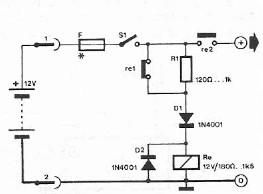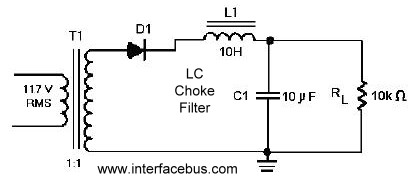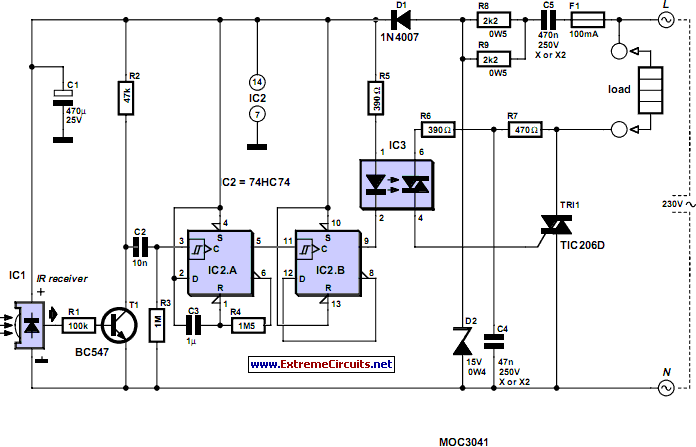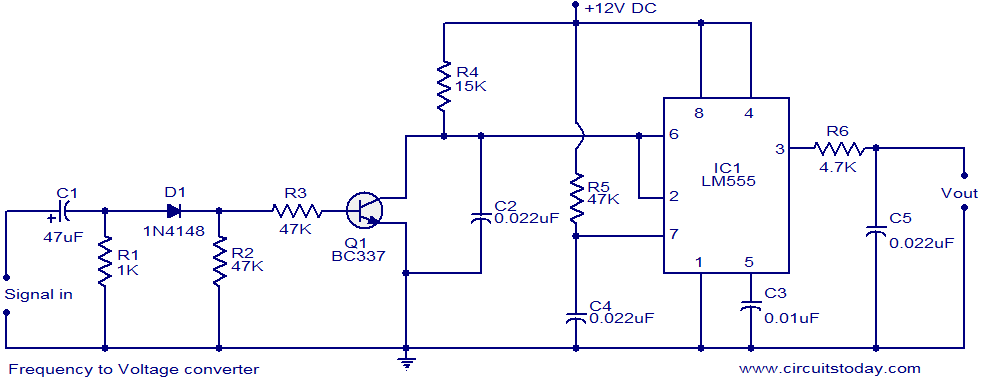
flip flop led flashing circuit
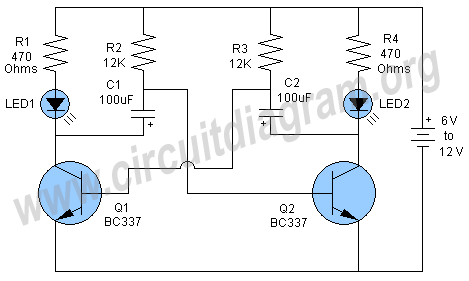
A schematic of a flip-flop LED flashing circuit is presented. This circuit functions as an astable multivibrator that activates LEDs sequentially upon power application. It is compatible with voltage inputs ranging from 6 to 12 volts, and can also operate with 3, 4, or 5 volts. The flashing rate can be adjusted by modifying the values of resistors R2, R3 and capacitors C1, C2. The circuit employs two general-purpose BC337 NPN transistors, although alternative transistors such as 2N2222 and 2N4401 can also be utilized.
The flip-flop LED flashing circuit operates as an astable multivibrator, creating a continuous square wave output that alternates between high and low states. When power is applied, the circuit initiates a sequence where the LEDs blink one after another, producing a visually appealing effect. The design is versatile, allowing for operation across a range of voltages from 3 to 12 volts, making it suitable for various applications and power supply configurations.
The timing characteristics of the flashing LEDs can be fine-tuned by adjusting the resistance and capacitance values in the circuit. Resistors R2 and R3, along with capacitors C1 and C2, determine the frequency of the oscillation, thus controlling how quickly the LEDs flash. For example, increasing the resistance or capacitance will slow down the flashing rate, while decreasing these values will speed it up.
The circuit utilizes two BC337 NPN transistors, which are key components for switching the LED states. These transistors are capable of handling moderate current levels, making them suitable for driving standard LEDs. However, other NPN transistors such as the 2N2222 and 2N4401 can be substituted without significant changes to the circuit's performance. This flexibility in component choice allows for easy sourcing and customization based on availability and specific project requirements.
Overall, this flip-flop LED flashing circuit is an excellent project for both beginners and experienced electronics enthusiasts, providing a practical demonstration of multivibrator operation and LED control while allowing for various configurations and adjustments.A very interesting schematic of Flip flop LED flashing circuit. The circuit actually is an astable multivibrator which starts blinking LEDs one by one when power is applied. This LED flasher circuit can be operated with any voltage from 6 to 12 volts, you can also operate the circuit with 3, 4 or 5 volts The flashing rate of the circuit can be inc
reased or decreased by changing the values of R2, R3, C1 and C2. The circuit is using two general purpose BC337 NPN transistors but you can also use other transistors for example 2N2222 and 2N4401 etc. 🔗 External reference
The flip-flop LED flashing circuit operates as an astable multivibrator, creating a continuous square wave output that alternates between high and low states. When power is applied, the circuit initiates a sequence where the LEDs blink one after another, producing a visually appealing effect. The design is versatile, allowing for operation across a range of voltages from 3 to 12 volts, making it suitable for various applications and power supply configurations.
The timing characteristics of the flashing LEDs can be fine-tuned by adjusting the resistance and capacitance values in the circuit. Resistors R2 and R3, along with capacitors C1 and C2, determine the frequency of the oscillation, thus controlling how quickly the LEDs flash. For example, increasing the resistance or capacitance will slow down the flashing rate, while decreasing these values will speed it up.
The circuit utilizes two BC337 NPN transistors, which are key components for switching the LED states. These transistors are capable of handling moderate current levels, making them suitable for driving standard LEDs. However, other NPN transistors such as the 2N2222 and 2N4401 can be substituted without significant changes to the circuit's performance. This flexibility in component choice allows for easy sourcing and customization based on availability and specific project requirements.
Overall, this flip-flop LED flashing circuit is an excellent project for both beginners and experienced electronics enthusiasts, providing a practical demonstration of multivibrator operation and LED control while allowing for various configurations and adjustments.A very interesting schematic of Flip flop LED flashing circuit. The circuit actually is an astable multivibrator which starts blinking LEDs one by one when power is applied. This LED flasher circuit can be operated with any voltage from 6 to 12 volts, you can also operate the circuit with 3, 4 or 5 volts The flashing rate of the circuit can be inc
reased or decreased by changing the values of R2, R3, C1 and C2. The circuit is using two general purpose BC337 NPN transistors but you can also use other transistors for example 2N2222 and 2N4401 etc. 🔗 External reference
